 | Monaco |  |
General data Area: 2.02 km²
Population: 32,800
Density: 16,400 inhab/km² (the highest in the world!)
Capital: Monaco
Languages : French
Origin: Monegasque and French
Religion: catholic
GNP per capita: USD 30,600 (one of the highest in the world)
Currency: Euro |  |
Inhabited since time immemorial, the Rock of Monaco became Roman, then was occupied and devastated by various barbarous tribes and the Saracens.
In 1191, Monaco becomes Genoese, and later a detachment of Ghibellines establishes there a fortress. By surprise, François de Grimaldi, known as François “the Malicious one”, disguised as a monk (this topic is reproduced on the Principality’s coat of arms), seizes the fortress on the 8th of January 1297.
The Grimaldi, under various names, are nowadays always there…
This authority, definitively established in 1314, was abolished only from 1793 to 1814, period of integration to France (under the name of Fort-Hercules). Placed under the protectorate of the Kingdom of Sardinia, Monaco finds again its full sovereignty in 1861.
Prince Charles III of Monaco creates then there the gambling houses prohibited in France, origin of the prosperity, sometimes sulfurous, of the Principality.
The absolute monarchy is transformed into constitutional monarchy in 1911 under Albert 1st.
Its great grandson Prince Rainier III succeeds him in 1949 for a 56 years long reign.
The constitution evolves in a increasingly democratic direction.
Periods of tension with the French State lead however to a clarification of the relationships between the two States, then to a proclamation of Sovereign state , with, as logical conclusion, an adhesion to UNO as 182nd member (right before San Marino), this establishing its international statute.
The new prince, Albert II will be able to give a new image of his country. The official language is the French.
Monaco and the Euro Monaco, taking into consideration its location inside France, always followed on the political level and economic its large neighbour, while jealously taking care on its specificity.
Economically integrated into the EU, without being one of its members, Monaco was in the same situation than the Vatican and San Marino. The EU gave mandate to France to negotiate its passage to the single currency.
As for the two other microstates, the solution found was to give to Monaco specific rights concerning the Euro: - national side
- exclusive right on the mintage, however subjected to the quotas admitted by the Mint of Paris (1/500th of the French mintage)
- identical application of the issuing’s rules than for the states members of the EU.
The minting workshop and the mintmarks
The coins of Monaco are produced by the Mint of Paris, as well for common strike than for the BU and PRF booklets, as that was practically always the case since the industrialization of coins striking, at the 19th century. The mintmarks are those of the Mint of Paris, it means, the horn of plenty  and the horseshoe and the horseshoe 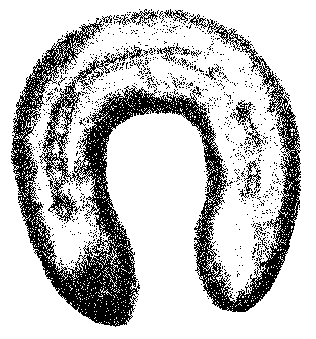 of Gerard Buquoy for 2001 and 2002, the heart of Serget Levet of Gerard Buquoy for 2001 and 2002, the heart of Serget Levet 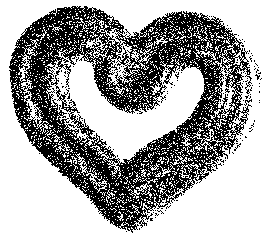 for 2003 and finally the hunting horn for 2003 and finally the hunting horn  of Hubert Larivière since 2004. of Hubert Larivière since 2004. Monaco exerted all its rights as regards to the issuing, for all that the Mint of Paris leaves it the possibility, and its policy is described as follows:: - a starter kit identical to the French one, for the contents and the values, was issued
- a policy firstly elistist, as for San Marino, with very limited series and high selling prices of the BU or PRF sets
- the limitations of emissions imposed by the Mint of Paris preserved the prices of BU and PRF sets rather high
- the possibility for Monaco of issuing a new series during the change of head of state. Prince Rainier III disappeared in April 2005, but it is only in 2006 that the first and single new series appears. That is probably due between other reasons to the limited quota of emission. Moreover the series is very limited (11,180 copies) and is only available in PRF condition at a very high price. The coins of 1, 2 and 5 cent were only slightly modified (the date, the mintmarks and the name of the Principality were displaced in the inner part, letting the European stars occupy all the outer ring). the new coins of 10, 20 and 50 cent feature the monogram of Prince Albert II, while the €1 and €2 coins feature his right profile. Taking into consideration its price and its distribution, this series will not have a real public impact… It will be necessary to wait until the beginning of 2008 to see the first current circulation coin: the €1 at the date 2007. This coin minted at 64,286 copies had firstly been struck without the mintmarks caused by a mistake. As soon as it was detected, the banks sent back the error coins to the Mint of Paris for being destroyed, but, according to the official figures, there would be 2,891 copies circulating without mintmarks. | From 2001 to 2005 |  |  |  | 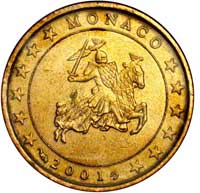 | | 1 cent | 2 cent | 5 cent | 10 cent | 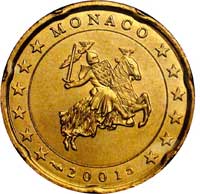 |  |  |  | | 20 cent | 50 cent | 1 euro | 2 euro | | From 2006 on | 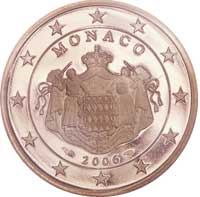 |  |  | 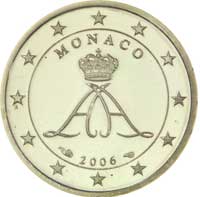 | | 1 cent | 2 cent | 5 cent | 10 cent | 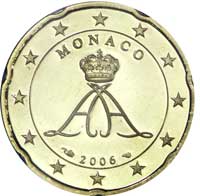 |  | 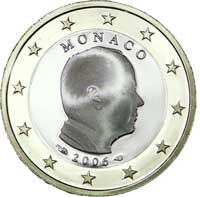 | 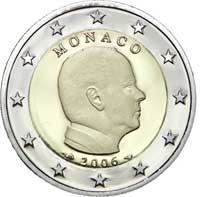 | | 20 cent | 50 cent | 1 euro | 2 euro |
The €2 commemorative coins Monaco, not taking part in the common issues so as San Marino and the Vatican, issued only one €2 commemorative coin when both other micro-states did not miss any since 2004. The distribution was carried out by the Museum of Stamps and Coins for the “moderate” amount of €135 at the beginning. The quotation did not cease climbing, this being especially related to the weak mintage of 20.001 copies. The €2 commemorative coins
| | 2007 |  | 25th anniversary of the death of Princess Grace
|
Contact Email : pays@amisdeleuro.org Links - Official website of the EU (Europa.eu):
Agreements on the monetary relations (Monaco, San Marino, the Vatican, Andorra), summary of the particular agreements on the Euro and of the corresponding texts… (in French) - Official website of the government of Monaco:
“History and Heritage”, (very) succint summary of the history of Monaco. - Agreement on the monetary relationships with the Principality of Monaco (in French)
Top of page |
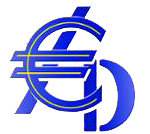 AD€ - Les Amis de l'Euro
AD€ - Les Amis de l'Euro














